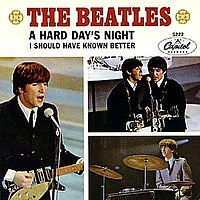Piano Sheets > John Lennon Sheet Music > A Hard Day's Night (ver. 1) Piano Sheet
A Hard Day's Night (ver. 1) by John Lennon - Piano Sheets and Free Sheet Music

About the Song
"A Hard Day's Night" is a song by English rock band The Beatles. Written by John Lennon, with help from Paul McCartney,[2] and credited to Lennon/McCartney; it was released on the movie soundtrack of the same name in 1964. It was later released as a single, with "I Should Have Known Better" as its B-side.
The song featured prominently on the soundtrack to The Beatles' first feature film, A Hard Day's Night, and was on their album of the same name. The song topped the charts in both the United Kingdom and United States when it was released as a single. Featuring a prominent and unique opening chord, the song's success demonstrated that The Beatles were not a one-hit wonder in the United States.
The American and British singles of "A Hard Day's Night" as well as both the American and British albums of the same title all held the top position in their respective charts for a couple of weeks in.
Download this sheet!
About the Artist

Random article
How to enhance sight-reading for piano sheet music If you want to learn how to play, the piano in a live performance impromptu then you need to improve your sight-reading of sheet music. Chances are you will have to play music notes, which are unfamiliar.
Picking it at random
One of the best ways to enhance your sight-reading of piano notes is to pick any book randomly and start playing. Ideally, you want to start playing these musical notes from the first page and continue until you reach the very end. The trick is to be stern with yourself and not stop playing until you reach the last page of the sheet music.
(More...)
